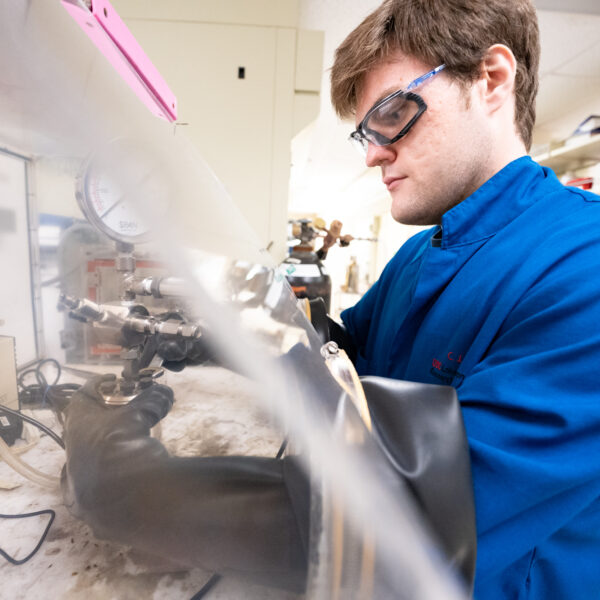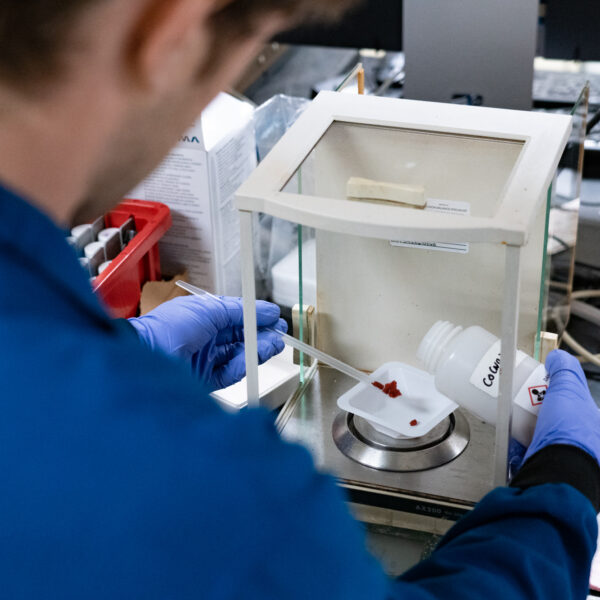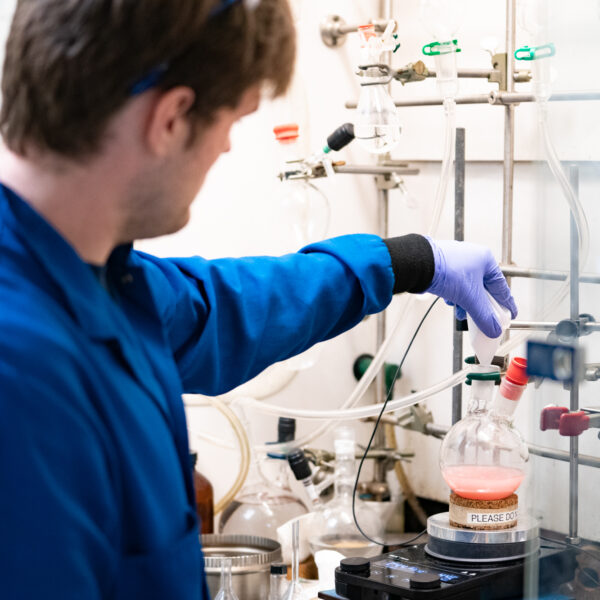Creating fuel from CO2
Hello! My name is CJ Koch, and I am a fourth year Ph.D. candidate working with Professor G.K. Surya Prakash in the Department of Chemistry at the University of Southern California. My doctoral research has focused on synthesizing novel catalysts for the conversion of carbon dioxide to fuels, which allows for carbon recycling. I am incredibly thankful for the funding from the Wrigley Institute, and I am excited to share a bit about both my research and my experience as a Ph.D. student.

Methanol Economy is a term coined by Professor Prakash and the late Nobel Laureate George A. Olah. This idea is similar to the hydrogen economy, where methanol can be used to replace the petroleum industry. Methanol is a small compound but packs a lot of punch; it can be used in gasoline engines and also undergo polymerization to help replace the petroleum refinery process, where many of our chemical feedstocks derive from. Most importantly, methanol can be transported by the infrastructure that already exists to accommodate the current gasoline industry.
Upon combustion, methanol produces carbon dioxide, a substance that contributes to the greenhouse gas effect. Luckily, there is a way to circumvent the environmental implications by utilizing the carbon dioxide from the atmosphere and use it as the source for methanol production. This concept is known as Integrated Carbon Dioxide Capture and Conversion (ICCC). In this system, carbon dioxide is directly captured from the atmosphere. This captured species is then converted to methanol. The methanol can then be used as a fuel, which will undergo combustion and release carbon dioxide. And once again, that carbon dioxide will be captured, and the cycle can continue. One carbon solution for a one carbon problem.
Current ICCC technologies utilize catalysts that are air sensitive and costly to synthesize. My research has been focused on synthesizing new catalysts that can perform ICCC at similar rates as current technologies. This is of economic value since methanol can be produced at similar rates to current expensive technologies at a much lower cost. Additionally, ICCC is a versatile technology. It does not have to produce only methanol as the final product. I have successfully prepared catalysts that can synthesize methane in ICCC processes. I know what you are probably thinking that methane is a worse greenhouse gas than carbon dioxide so why would I want to synthesize methane. The reason is that methane constitutes a large portion of natural gas and natural gas makes up 34% of the United States’ current energy consumption. Thus, creating a way to synthesize renewable methane is of interest as that methane can integrate into the already existing infrastructure rather than building new infrastructure around a new fuel source.

The work I have done in my Ph.D. career is not all in the laboratory though. I am a firm believer that science is something that everyone should have access to. Science is often not accessible for many communities, especially those that are disadvantaged. However, many problems that are often faced by disadvantaged communities, like water quality issues, air quality issues, and many common issues can be solved, or at least addressed, if communities have access to scientific analysis techniques. For this reason, I partnered with the Thriving Earth Exchange to work with a community on the dangers of graphite mining and the implications that can have on their water quality.
I am also currently working with the Netherland Innovation Network (NIN) on a science diplomacy project. Science diplomacy is a field that has grown in the past ten years with several current events showcasing the need for science in diplomatic efforts. In fact, the COVID pandemic showcases how necessary science diplomacy is needed as science was determining how countries were interacting with each other. Countries were also needed to work with each other on public health issues and research for possible prevention and curative measures. I work in the NIN-Boston with two other graduate students to identify ways to improve collaborations between the Netherlands and the United States. We focus on important innovation hubs, like Boston for the United States and Eindhoven for the Netherlands. Both of these cities have a high concentration of startup companies and identifying policies that improve the success of these companies will allow us to make comparisons between the two cities and make suggestions on how collaboration can improve these startups even more.

Then something that is near and dear to my heart is science policy. For such a long time in my life I did not even know that there are scientists that are helping to inform lawmakers on scientific issues and that getting a Ph.D. would even prepare me for a job like that. I always thought that those positions were for people who went to law school. However, that is not the case at all. Departments, like the Department of Energy and agencies, like the Environmental Protection Agency, both hire scientists as policy analysts. Even National Aeronautics and Space Administration (NASA) hire scientists as policy analysts. I wanted to gain more experience in science policy while in my Ph.D. career, so I reached out to Senator Ben Allen’s office for a potential volunteer opportunity. Luckily, they agreed to the collaboration and I now get to be involved in the Californian State legislative process. This opportunity has been really rewarding as it has allowed me to see science in action at a large scale. I can now see how science can be utilized to help many people at once rather than me being in a lab and mixing chemicals together.

Thank you so much for reading this! I would like to give another huge shoutout to the Wrigley Institute for both the fellowship and all their advice. I would not have even thought to leverage my scientific knowledge into some of the opportunities I talked about in this post if it were not for their encouragement. Fight on!
